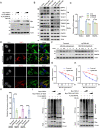FBXL4 mutations cause excessive mitophagy via BNIP3/BNIP3L accumulation leading to mitochondrial DNA depletion syndrome
- PMID: 37568009
- PMCID: PMC10589232
- DOI: 10.1038/s41418-023-01205-1
FBXL4 mutations cause excessive mitophagy via BNIP3/BNIP3L accumulation leading to mitochondrial DNA depletion syndrome
Abstract
Mitochondria are essential organelles found in eukaryotic cells that play a crucial role in ATP production through oxidative phosphorylation (OXPHOS). Mitochondrial DNA depletion syndrome (MTDPS) is a group of genetic disorders characterized by the reduction of mtDNA copy number, leading to deficiencies in OXPHOS and mitochondrial functions. Mutations in FBXL4, a substrate-binding adaptor of Cullin 1-RING ubiquitin ligase complex (CRL1), are associated with MTDPS, type 13 (MTDPS13). Here, we demonstrate that, FBXL4 directly interacts with the mitophagy cargo receptors BNIP3 and BNIP3L, promoting their degradation through the ubiquitin-proteasome pathway via the assembly of an active CRL1FBXL4 complex. However, MTDPS13-associated FBXL4 mutations impair the assembly of an active CRL1FBXL4 complex. This results in a notable accumulation of BNIP3/3L proteins and robust mitophagy even at basal levels. Excessive mitophagy was observed in Knockin (KI) mice carrying a patient-derived FBXL4 mutation and cortical neurons (CNs)-induced from MTDPS13 patient human induced pluripotent stem cells (hiPSCs). In summary, our findings suggest that abnormal activation of BNIP3/BNIP3L-dependent mitophagy impairs mitochondrial homeostasis and underlies FBXL4-mutated MTDPS13.
© 2023. The Author(s), under exclusive licence to ADMC Associazione Differenziamento e Morte Cellulare.
Conflict of interest statement
The authors declare no competing interests.
Figures







Similar articles
-
PPTC7 acts as an essential co-factor of the SCFFBXL4 ubiquitin ligase complex to restrict BNIP3/3L-dependent mitophagy.Cell Death Dis. 2025 Mar 1;16(1):145. doi: 10.1038/s41419-025-07463-w. Cell Death Dis. 2025. PMID: 40025034 Free PMC article.
-
Excessive BNIP3- and BNIP3L-dependent mitophagy underlies the pathogenesis of FBXL4-mutated mitochondrial DNA depletion syndrome.Autophagy. 2024 Feb;20(2):460-462. doi: 10.1080/15548627.2023.2274260. Epub 2024 Jan 25. Autophagy. 2024. PMID: 37876279 Free PMC article.
-
FBXL4 mutation-caused mitochondrial DNA depletion syndrome is driven by BNIP3/BNIP3L-dependent excessive mitophagy.Trends Mol Med. 2024 Feb;30(2):113-116. doi: 10.1016/j.molmed.2023.11.017. Epub 2023 Dec 19. Trends Mol Med. 2024. PMID: 38123379
-
Molecular and clinical spectra of FBXL4 deficiency.Hum Mutat. 2017 Dec;38(12):1649-1659. doi: 10.1002/humu.23341. Epub 2017 Oct 6. Hum Mutat. 2017. PMID: 28940506 Review.
-
Diverse routes to mitophagy governed by ubiquitylation and mitochondrial import.Trends Cell Biol. 2025 Jun;35(6):527-538. doi: 10.1016/j.tcb.2025.01.003. Epub 2025 Feb 7. Trends Cell Biol. 2025. PMID: 39922712 Review.
Cited by
-
Mitochondrial diseases: from molecular mechanisms to therapeutic advances.Signal Transduct Target Ther. 2025 Jan 10;10(1):9. doi: 10.1038/s41392-024-02044-3. Signal Transduct Target Ther. 2025. PMID: 39788934 Free PMC article. Review.
-
Coordinating BNIP3/NIX-mediated mitophagy in space and time.Biochem Soc Trans. 2024 Oct 30;52(5):1969-1979. doi: 10.1042/BST20221364. Biochem Soc Trans. 2024. PMID: 39377319 Free PMC article. Review.
-
Mitophagy-associated programmed neuronal death and neuroinflammation.Front Immunol. 2024 Oct 2;15:1460286. doi: 10.3389/fimmu.2024.1460286. eCollection 2024. Front Immunol. 2024. PMID: 39416788 Free PMC article. Review.
-
PPTC7 acts as an essential co-factor of the SCFFBXL4 ubiquitin ligase complex to restrict BNIP3/3L-dependent mitophagy.Cell Death Dis. 2025 Mar 1;16(1):145. doi: 10.1038/s41419-025-07463-w. Cell Death Dis. 2025. PMID: 40025034 Free PMC article.
-
Targeting mitophagy in neurodegenerative diseases.Nat Rev Drug Discov. 2025 Apr;24(4):276-299. doi: 10.1038/s41573-024-01105-0. Epub 2025 Jan 14. Nat Rev Drug Discov. 2025. PMID: 39809929 Review.
References
MeSH terms
Substances
Grants and funding
- No. 91957125, 81972396/National Natural Science Foundation of China (National Science Foundation of China)
- 82272992 and 91954106/National Natural Science Foundation of China (National Science Foundation of China)
- 31821002, 31930062/National Natural Science Foundation of China (National Science Foundation of China)
- 82071269/National Natural Science Foundation of China (National Science Foundation of China)
LinkOut - more resources
Full Text Sources

